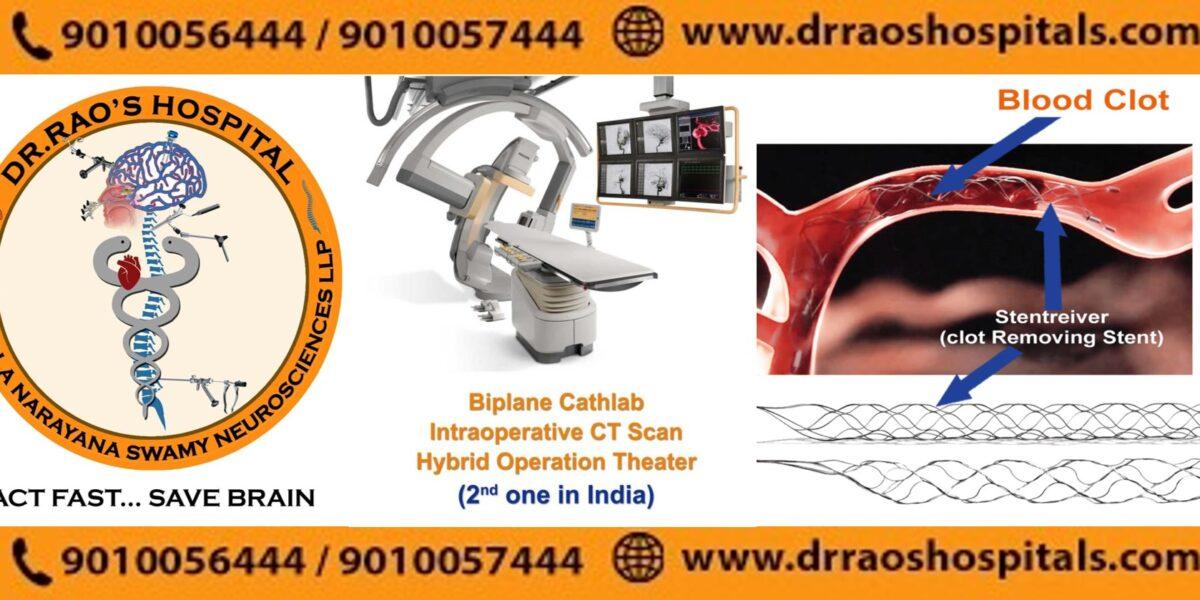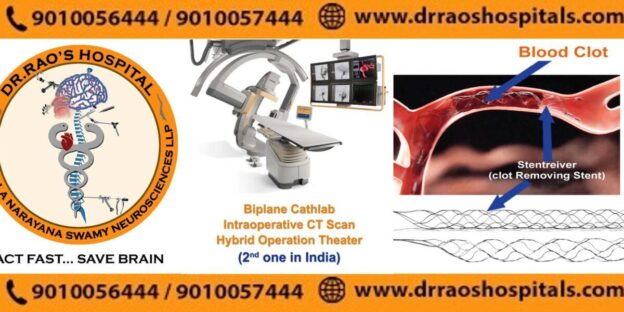Recognizing the Signs of a Stroke: The Crucial Role of Timely Medical Intervention at Dr. Rao’s Hospital, Guntur
Recognizing the Signs of a Stroke: The Crucial Role of Timely Medical Intervention at Dr. Rao’s Hospital, Guntur
“Discover the essential signs and symptoms of a stroke and learn why timely medical intervention is crucial. Dr. Rao’s Hospital in Guntur provides expert stroke care, led by highly skilled specialists. Understand the importance of recognizing stroke symptoms and seeking immediate medical attention. Trust Dr. Rao’s Hospital for prompt and effective stroke treatment in Guntur.”
Watch More On YouTube
Introduction: A stroke is a medical emergency that requires immediate attention. Recognizing the signs and symptoms of a stroke is crucial for timely medical intervention, which can greatly impact the patient’s outcome. In this blog, we will delve into the importance of recognizing stroke symptoms and highlight the expertise of Dr. Rao, the best stroke endovascular neurosurgeon, and Dr. Rao’s Hospital, the leading comprehensive stroke center in Guntur and India.
Understanding Stroke: A stroke occurs when blood flow to the brain is disrupted, leading to damage or death of brain cells. It is essential to understand the different types of stroke, including ischemic and hemorrhagic strokes, as the symptoms and treatment approaches may vary.

Risk factors for stroke can be categorized into two main types: modifiable and non-modifiable risk factors. Modifiable risk factors are those that can be changed or managed, while non-modifiable risk factors are those that cannot be changed. It’s important to identify and address these risk factors to reduce the likelihood of experiencing a stroke. Here are some common risk factors:

- Modifiable Risk Factors:
- High Blood Pressure (Hypertension): High blood pressure is the most significant modifiable risk factor for stroke. It damages the blood vessels and increases the risk of atherosclerosis, blood clots, and rupture of blood vessels.
- Smoking: Cigarette smoking increases the risk of stroke by damaging blood vessels, promoting blood clots, and reducing the amount of oxygen in the blood.
- Diabetes: Uncontrolled diabetes can damage blood vessels and increase the risk of atherosclerosis and stroke.
- High Cholesterol: High levels of LDL (low-density lipoprotein) cholesterol and triglycerides can lead to the formation of plaque in the arteries, increasing the risk of stroke.
- Obesity: Excess weight and obesity contribute to other risk factors such as high blood pressure, diabetes, and high cholesterol levels.
- Physical Inactivity: Lack of regular physical activity can increase the risk of stroke and other cardiovascular diseases.
- Poor Diet: A diet high in saturated fats, cholesterol, sodium, and processed foods and low in fruits, vegetables, and whole grains increases the risk of stroke.
- Non-Modifiable Risk Factors:
- Age: The risk of stroke increases with age. The incidence of stroke doubles with each decade after the age of 55.
- Gender: Men have a slightly higher risk of stroke compared to women, although women’s risk increases after menopause.
- Family History: Having a close family member who has experienced a stroke increases the risk of stroke.
- Race and Ethnicity: Certain racial and ethnic groups, such as African Americans, Hispanics, and Asians, have a higher risk of stroke.
- Prior Stroke or Transient Ischemic Attack (TIA): Having a previous stroke or TIA increases the risk of subsequent strokes.
It’s important to note that having one or more risk factors does not guarantee that a stroke will occur, and individuals without any known risk factors can still experience a stroke. However, managing and controlling modifiable risk factors can significantly reduce the risk of stroke. Lifestyle modifications, such as maintaining a healthy weight, exercising regularly, eating a balanced diet, quitting smoking, managing blood pressure, cholesterol, and diabetes, are key to stroke prevention. Regular check-ups with healthcare professionals are essential for assessing and managing stroke risk factors effectively.
Recognizing Stroke Symptoms: Learning to recognize the signs and symptoms of a stroke can save lives. Common symptoms include sudden numbness or weakness on one side of the face or body, difficulty speaking or understanding speech, severe headache, vision problems, and loss of balance or coordination. If any of these symptoms occur suddenly, it is crucial to seek immediate medical attention.

The Importance of Timely Medical Intervention: Time is of the essence when it comes to stroke treatment. Every minute counts, as early medical intervention can minimize brain damage and improve outcomes. Dr. Rao, the best stroke endovascular neurosurgeon at Dr. Rao’s Hospital, emphasizes the significance of recognizing stroke symptoms and seeking immediate medical help. The time limits for the acute treatment of ischemic stroke and hemorrhagic stroke vary depending on the specific treatment options available and the individual patient’s condition. However, there are general guidelines that healthcare professionals follow to ensure the best outcomes: Ischemic Stroke: For ischemic strokes, the most common type of stroke, the following time frames are typically considered: Intravenous Thrombolysis (IVT): The administration of clot-dissolving medication (tissue plasminogen activator or tPA) is recommended within 4.5 hours from the onset of stroke symptoms. IVT is most effective when given as early as possible within this time window. Endovascular Thrombectomy: This procedure involves removing the blood clot causing the stroke using specialized catheters and devices. Endovascular thrombectomy is typically performed within 6 to 24 hours from symptom onset, depending on the specific criteria and guidelines established by medical societies.

It’s important to note that these time limits are general guidelines, and individual cases may vary. In some cases, patients may still benefit from treatment beyond the typical time frames, particularly if they meet specific eligibility criteria or have certain factors that suggest a favorable response to treatment. Hemorrhagic Stroke: Hemorrhagic strokes, which involve bleeding in the brain, have different treatment considerations. The primary goals are to stabilize the patient and prevent further bleeding or complications. Time limits for specific interventions may vary depending on the severity and location of the bleed. Surgical Intervention: In some cases of hemorrhagic stroke, surgical intervention may be necessary to remove the blood clot or repair the source of bleeding. The timing of surgical intervention depends on various factors, including the patient’s stability, the location and size of the bleed, and the expertise and availability of the surgical team.

Supportive Care: Hemorrhagic stroke management often involves close monitoring, blood pressure control, and supportive care to minimize complications and promote recovery. The focus is on stabilizing the patient’s condition and addressing any underlying causes contributing to the bleeding. It’s important to recognize that early recognition and prompt medical attention are crucial for both types of stroke. If you or someone you know experiences stroke symptoms, it is essential to seek immediate medical help, as every minute counts in determining the appropriate treatment options and potentially improving the outcome.
Expert Stroke Care at Dr. Rao’s Hospital: Dr. Rao’s Hospital is a recognized comprehensive stroke center in Guntur and India, offering state-of-the-art facilities and specialized care for stroke patients. As the best stroke endovascular neurosurgeon, Dr. Rao has extensive experience in treating strokes using advanced endovascular techniques, such as thrombectomy, to restore blood flow and minimize brain damage.

The comprehensive stroke treatment approach at Dr. Rao’s Hospital is designed to provide patients with the highest level of care and support throughout their stroke journey. This approach involves a multidisciplinary team of highly skilled professionals who work collaboratively to ensure timely diagnosis, effective treatment, and ongoing support during the recovery process. Neurologists: Neurologists play a crucial role in stroke treatment by evaluating and diagnosing the type and severity of the stroke. They specialize in assessing neurological symptoms, conducting diagnostic tests such as brain imaging, and determining the appropriate treatment plan. Neurologists at Dr. Rao’s Hospital have extensive experience in managing various types of strokes and are at the forefront of cutting-edge advancements in stroke care. Neurosurgeons: Neurosurgeons bring their expertise in surgical interventions for stroke cases that require immediate intervention, such as hemorrhagic strokes or certain cases of ischemic strokes. They perform intricate procedures, such as aneurysm clipping or hematoma evacuation, to remove or repair the source of bleeding and alleviate pressure on the brain. Dr. Rao, the best stroke endovascular neurosurgeon, specializes in minimally invasive endovascular techniques to restore blood flow and treat complex strokes. Interventional Radiologists: Interventional radiologists are instrumental in providing minimally invasive procedures to treat strokes. They utilize advanced imaging techniques to guide catheters and tools to the affected blood vessels, performing procedures like thrombectomy to remove blood clots and restore blood flow to the brain. The expertise of interventional radiologists at Dr. Rao’s Hospital ensures that patients have access to the latest and most effective treatment options. Rehabilitation Specialists: Rehabilitation is a crucial component of stroke treatment to help patients regain their functional abilities and improve their quality of life. Rehabilitation specialists, including physical therapists, occupational therapists, and speech therapists, work closely with patients to develop personalized rehabilitation plans. These plans address motor skills, speech and language abilities, cognitive function, and activities of daily living. The rehabilitation team at Dr. Rao’s Hospital provides comprehensive therapy and support to optimize recovery and maximize independence. Ongoing Support and Follow-up Care: The stroke treatment approach at Dr. Rao’s Hospital extends beyond the acute phase of care. The team is committed to providing ongoing support and follow-up care to ensure that patients have the resources and guidance they need during their recovery journey. Regular follow-up appointments, education on stroke prevention, and lifestyle modifications are integral components of the comprehensive treatment approach. By combining the expertise of multiple specialists, Dr. Rao’s Hospital ensures that each stroke patient receives individualized and comprehensive care. The collaborative efforts of neurologists, neurosurgeons, interventional radiologists, and rehabilitation specialists enable timely diagnosis, effective treatment, and ongoing support throughout the recovery process. This multidisciplinary approach contributes to better outcomes and improved quality of life for stroke patients.
Rehabilitation and Post-Stroke Care: Recovering from a stroke requires specialized rehabilitation services and post-stroke care. Dr. Rao’s Hospital offers comprehensive rehabilitation programs tailored to the unique needs of each patient. These programs focus on physical therapy, speech therapy, occupational therapy, and psychological support to maximize recovery and improve quality of life.
Public Awareness and Education: Dr. Rao and his team are passionate about raising public awareness regarding stroke prevention and recognizing the signs of a stroke. They actively participate in community outreach programs, conducting awareness campaigns to educate people about stroke symptoms, risk factors, and the importance of timely medical intervention.
Conclusion: Recognizing the signs of a stroke and seeking immediate medical intervention can be life-saving. Dr. Rao, the best stroke endovascular neurosurgeon, and Dr. Rao’s Hospital, the leading comprehensive stroke center in Guntur and India, are committed to providing timely and advanced stroke care. By prioritizing public awareness, early intervention, and comprehensive treatment, they are dedicated to improving stroke outcomes and helping patients achieve the best possible recovery.


